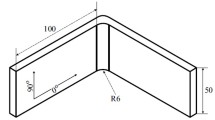Abstract
Curing deformation of the T-shaped integrated structures is discussed in this paper. The mechanism of the deformation is analyzed for the T-shaped integrated structures, and a simple mathematical model for the deformation of the T-shaped integrated structures is established. Compare the mathematical model with the finite element analysis, the results show a good agreement. From the simple mathematical model, it can be seen that both cure shrinkage and thermal expansion are the major factors to produce the deformation of the typical T-shaped integrated structures and the tool-part contraction is the secondary factor. Therefore, it is important for the T-shaped integrated structures to select suitable fabrication process and the appropriate tool. The different geometry and material parameters of the T-shaped integrated structures are studied, and then a regression model is established.












Similar content being viewed by others
References
Mahfuz, H., Prasun, M., Mrinal, S., et al.: Integral manufacturing of composite skin-stringer assembly and their stability analysis. Appl. Compos. Mater. 11, 155–171 (2004). doi:10.1023/B:ACMA.0000026585.37973.c8
Wisnom, M.R., Gigliotti, M., Ersoy, N., Campbell, M., Potter, K.D.: Mechanisms generating residual stresses and distortion during manufacture of polymer-matrix composite structures. Compos. Part A 37(4), 522–529 (2006). doi:10.1016/j.compositesa.2005.05.019
Fernlund, G., Rahman, N., Courdji, R., Bresslauer, M., Poursartip, A., Willden, K., Nelson, K.: Experimental and numerical study of the effect of cure cycle, tool surface, geometry, and lay-up on the dimensional fidelity of autoclave-processed composite parts. Compos. Part A 33(3), 341–351 (2002). doi:10.1016/S1359-835X(01)00123-3
Bogetti, T.A.: Process-induced stress and deformation in thick-section thermoset composite laminates. J. Compos. Mater. 26(5), 626–660 (1992). doi:10.1177/002199839202600502
Radford, D.W., Rennick, T.S.: Separating sources of manufacturing distortion in laminated composites. J. Reinf. Plast.Comp. 19(8), 621–641 (2000). doi:10.1106/CRMP-ARE5-GVPP-0Y7N
Fernlund, G.: Spring-in of angled sandwich panels. Compos. Sci. Technol. 65, 317–323 (2005). doi:10.1016/j.compscitech.2004.08.001
Albert, C., Fernlund, G.: Spring-in and warpage of angled composite laminates. Compos. Sci. Technol. 62, 1895–1912 (2002). doi:10.1016/S0266-3538(02)00105-7
Huang, C.K., Yang, S.Y.: Warping in advanced composite tools with varying angles and radii. Compos. Part A 28, 891–893 (1997). doi:10.1016/S1359-835X(97)00045-6
Huang, C.K., Yang, S.Y.: Study on accuracy of angled advanced composite tools. Mater. Manuf. Process. 12(3), 473–486 (1997). doi:10.1080/10426919708935158
Jung, W.K., Chu, W.S., Ahn, S.H.: Measurement and compensation of spring-back of a hybrid composite beam. J. Compos. Mater. 41(7), 851–864 (2007). doi:10.1177/0021998306067064
Twigg, G., Poursartip, A., Fernlund, G.: Tool-part interaction in composites processing. Part I: experimental investigation and analytical model. Compos. Part A 35, 121–133 (2004). doi:10.1016/S1359-835X(03)00131-3
Wang, J., Kelly, D.: Finite element analysis of temperature induced stresses and deformations of polymer composite components. J. Compos. Mater. 34(17), 1456–1471 (2000). doi:10.1106/76G7-X9QM-C5JF-E4D5
Fernlund, G., Osooly, A., Poursartip, A., et al.: Finite element based prediction of processed-induced deformation of autoclaved composite structures using 2D process analysis and 3D structural analysis. Compos. Struct. 62, 223–234 (2003). doi:10.1016/S0263-8223(03)00117-X
Johnston, A., Vaziri, R., Poursartip, A.: A plane strain model for process-induced deformation of laminated composite structures. J. Compos. Mater. 35(16), 1435–1469 (2001)
Fernlund, G., Floyd, A.: Process analysis and tool compensation for curved composite L-angles. The 6th Canadian international composites conference p, 14–17 (2007)
Dong, C.S., Zhang, C., Liang, Z.Y., Wang, B.G.: Dimension variation prediction for composites with finite element analysis and regression modeling. Compos. Part A 35, 735–746 (2004). doi:10.1016/j.compositesa.2003.12.005
Acknowledgements
This work was supported by National Natural Science Foundation of China (10772094).
Author information
Authors and Affiliations
Corresponding author
Appendix: Continuous Fiber Micromechanics Model
Appendix: Continuous Fiber Micromechanics Model
In the equations presented below, the subscripts 1, 2 and 3 refer to the directions in the principal coordinate system of the lamina. Subscripts m, f and c correspond to the matrix(resin),fiber and composite properties, respectively. Fiber volume fraction of the lamina is denoted as V f and k is the isotropic plane strain bulk modulus defined by
The following equations define the transversely isotropic engineering constants of the lamina. The longitudinal Young’s modulus:
The major Poisson’s ration:
The in-plane shear modulus:
The transverse shear modulus:
The transverse Young’s modulus:
where K 2c is the effective plane strain bulk modulus of the composite given by
The transverse Poisson’s ration:
The following equations define the transversely isotropic thermal expansion coefficient of the lamina. The longitudinal direction thermal expansion coefficient:
The transverse direction thermal expansion coefficient:
Rights and permissions
About this article
Cite this article
Li, J., Yao, X., Liu, Y. et al. Curing Deformation Analysis for the Composite T-shaped Integrated Structures. Appl Compos Mater 15, 207–225 (2008). https://doi.org/10.1007/s10443-008-9068-0
Received:
Accepted:
Published:
Issue Date:
DOI: https://doi.org/10.1007/s10443-008-9068-0



